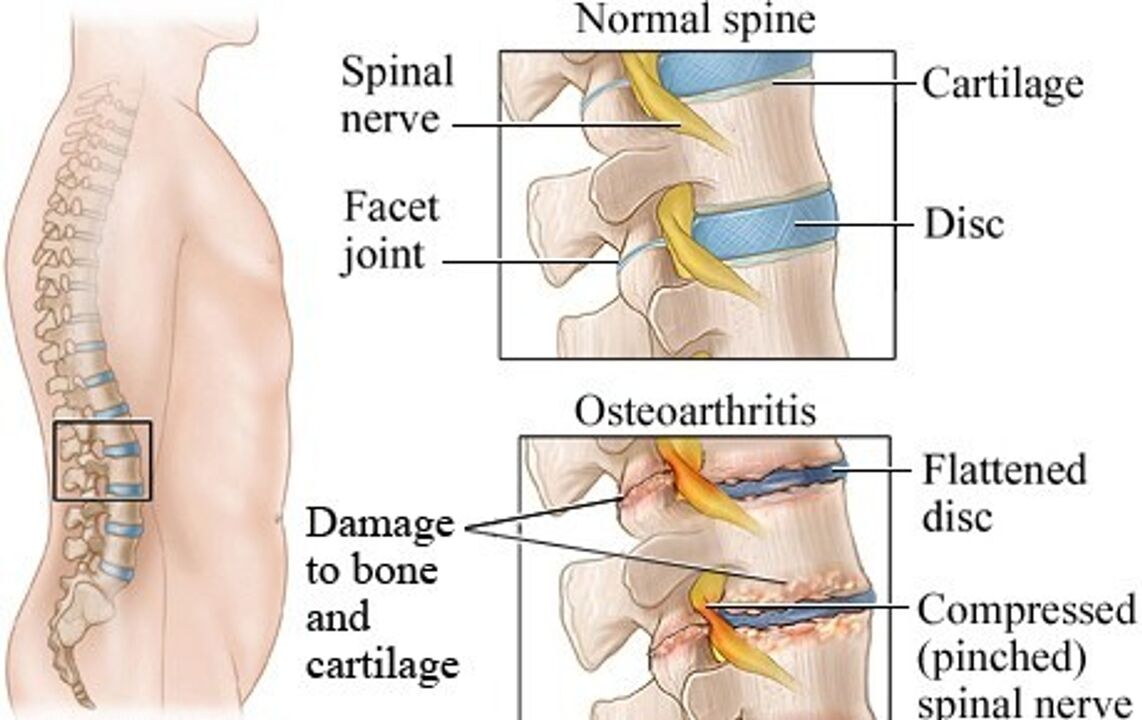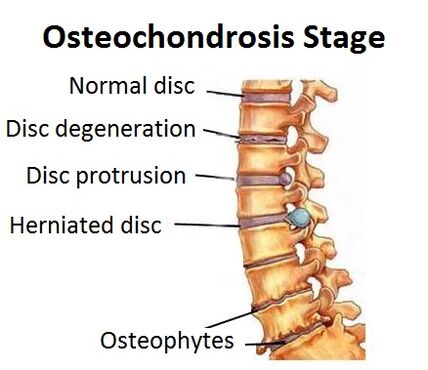One of the most common problems of the spine is non -specific pain in the back of the back.According to the National Center for Health Statistics, 26-32% of the adult population suffers from chronic lower back pain.A common cause of such pain is osteochondrosis.
Osteochondrosis is premature wear and aging of intervertebral discs and vertebrae.Osteochondrosis can occur to any part of the spine: cervical, chest, lumbar or lumbar.The lumbar segment is most often affected and lumbar osteochondrosis is developing.If you do not start treating in time, the disease can affect several departments at once.

Osteochondrosis of the lumbar region is a chronic degenerative disease in which the cartilage tissue of the intervertebral discs in the lumbar region is destroyed.There are two main parts in the intervertebral disk: the core and fibrous ring.With increased load, these structures are destroyed, which leads to compression of the nerves and the appearance of acute pain.
Since the disease develops slowly, its signs are difficult to notice at first.The patient does not pay attention or does not even understand exactly where it hurts.Because of this, often they already come to the doctor at the moment when the intervertebral hernia develops.
The causes of osteochondrosis
Lumbar osteochondrosis, like most diseases of the musculoskeletal system, has non-infectious etiology.Risk factors for the development of osteochondrosis are mainly associated with the motor activity of a person, lifestyle, professional working conditions, as well as heredity.Let us dwell on the main and perhaps the most important factors.
Violation of posture and reduction of motor activity.Given the modern rhythm of life, people have to be in one position for a long time, whether it is office work, driving a car or study.Because of this, a large number of people have problems with the back-a violation of posture, including scoliosis.When the posture is broken, the load on the spinal column is distributed unevenly: some discs are loaded more than others.The lumbar region suffers more than others.And in the case of the lumbar department, this load is many times more than on other departments.
Excessive physical activity.When a person does not play sports and his back muscles are weak, intense training can harm.Exercises with additional burden and excessive load on the lumbar region lead to injuries, intervertebral discs wear ahead of time.
Excess body weight and obesityIncrease the axial load on the spine.At the same time, the nutrition of the intervertebral discs is disturbed due to which dystrophic processes develop.
Age -related changes.After 60 years, tissue restoration processes slow down, so in older people the probability of developing intervertebral hernias higher.
Hereditary factors.If a person is naturally disturbed by the properties of cartilage and bone tissues, then his osteochondrosis develops earlier and will progress will be faster.
The first signs and main symptoms of lumbar osteochondrosis
Intervertebral discs soften shocks while walking, running and jumping.Due to the structural changes that accompany the lumbar osteochondrosis, this function suffers.
When intervertebral discs for osteochondrosis become thinner, this leads to an increase in the vulnerability of nerves and blood vessels.The nerves are pinched and their nutrition is disturbed, acute pain and other symptoms of lumbar osteochondrosis appear.
Sharp and chronic lower back pain- This is the main complaint with lumbar osteochondrosis.Personal activity, hypothermia, uncomfortable pose can cause pain.Sometimes the pain extends to the entire back and leg.
Tingling, burning and numbness (paresthesia) in the lower back and legs-Frequent symptom of lumbar osteochondrosis, which appears due to compression of the nerves.
Increase in the tone of the back muscles in the lumbar regionIt can increase pain and lead to a decrease in mobility.
Stages of osteochondrosis of the lumbar

Changes in cartilage and bone tissue occur slowly.Depending on the prevalence of the pathological process, four stages of lumbar osteochondrosis are distinguished.
1st stage.This is the onset of the disease (Chondrosis).The location of the gelatinous nucleus of the disk relative to fibers of the fibrous ring changes.This leads to irritation of nerves and pain.Sometimes nothing hurts at this stage.
Stage 2.Due to the displacement of the discs, the intervertebral gap is reduced, cracks appear in the discs.The nerves are compressed, and the patient suffers from acute lower back pain.
Stage 3.Intervertebral discs are completely damaged, a fibrous ring is destroyed.At this stage, the risk of developing intervertebral hernia is high.The pain intensifies, appears more often and has a different character: from acute to chronic aching.
4th stage.The disease applies to nearby tissues.In the lumbar region, mobility is reduced, pain occurs even with minor changes in the position of the body.In this stage, intervertebral hernias are developing and the risk of compression of nerves and blood vessels in the lumbar region is high.
Diagnosis of osteochondrosis of the lumbar
If you are tormented by acute lower back pain both when moving and at rest, numbness of the legs - contact a neurologist.He will conduct an inspection, determine the probable cause of pain and prescribe the necessary diagnosis.
The main research methods are radiography and tomography.
- Sight, sighting and functional radiography of the spine in two projections.This method allows you to evaluate the condition of the spine, but soft tissues (for example, muscles) and cartilage in the pictures are not displayed.
- Computed tomography allows you to get more information, as the pictures are obtained in different projections.Based on the results of the study, the doctor can determine the degree of damage to the lumbar spine.
- Magnetic resonance imaging is the “gold standard” for the accurate diagnosis of “lumbar osteochondrosis”.According to the MRI, the doctor can evaluate the condition of the soft tissues and identify the hernia between the vertebrae.
Treatment of lumbar osteochondrosis
After making a diagnosis, the neurologist individually selects treatment.It depends on the stage of the disease and the severity of the symptoms.Most patients are helped by comprehensive conservative treatment (drug therapy, physiotherapy exercises, physiotherapy).If the patient is not better and serious complications develop, the operation is prescribed.
Conservative treatment
Conservative treatment tasks:
- Stop pain.
- Reduce inflammation.
- Prevent the development of complications.
- Reduce the load on the spine by strengthening the muscles of the back.
- Reduce compression of the nerves.
- In the intervertebral hernia - create conditions for its resorption and natural healing.
In the acute phase of the disease, the doctor primarily reduces pain and inflammation with analgesics and anti -inflammatory drugs.After that, the neurologist draws up an individual program consisting of physiotherapy, manual therapy and physiotherapy exercises.
PhysiotherapyIt is based on the use of physical factors: cold, heat, electric current, magnetic radiation, laser, etc. They help reduce the intensity of pain and improve tissue nutrition, which contributes to their natural restoration.
KinesitherapyIt is active (exercise therapy) and passive (massage, traction).It allows you to strengthen the muscles of the back, relieve muscle tension, improve microcirculation and activate recovery processes.
Manual therapy and massageRemove an increased muscle tone in the lower back, restore mobility.Due to this, the nutrition of the damaged area improves and the degree of pinching of the nerves decreases.
TapingOr Kinesiological Taping is based on the use of elastic plasters, which are glued to the skin to weaken or enhance muscle tone.So the muscle frame is strengthened, microcirculation in the lumbar region improves and the distribution of the load on the spine is normalized.
Laser therapyIt is based on the use of low -intensity laser radiation and its positive effects on the functioning of cells.It contributes to the natural restoration of intervertebral discs by improving their nutrition.
Plasma Therapy(PRP therapy)-a method for improving regeneration processes.Injections of the patient's purified plasma stimulate his immunity.
Reflexotherapy, acupunctureImprove blood supply to the affected areas, reduce pain.
Shock wave therapy- This is the effect of high -frequency waves on the affected area.It stimulates the natural processes of tissue regeneration and improves tissue nutrition.
Orthopedics- Individual selection of corsets for additional support of the spine.Allows partially compensate for the load on the spine.When wearing a corset, pain decreases, the mobility and quality of the patient’s life increases.
Lumbar osteochondrosis is a chronic disease.It is important that the patient changes his lifestyle and learn to live with this disease.To do this, there are special educational programs that can improve the quality of the patient's life.
The positive effect of conservative treatment is achieved in 2-3 months.If such treatment is ineffective, the operation is prescribed.
Operation
With the development of intervertebral hernias of the lumbar department, minimally invasive surgical operations are carried out.The choice in the direction of neurosurgical treatment is made with special indications, in severe, threatening the patient's lives.
Operation is a complex invasive treatment method that is associated with risks.During or after surgery, complications may develop.And the success of treatment also depends on postoperative rehabilitation, which includes methods of conservative therapy and orthopedic correction.
Do not postpone treatment
Lumbar osteochondrosis is a progressive disease.If it is not detected in time and not starting to treat it, it can lead to disability and a decrease in the quality of life.Over time, several parts of the spine are affected, the pain made of acute goes into a chronic one.
Timely prevention of symptoms and the treatment of lumbar osteochondrosis in the initial stages can prevent the development of the disease and a deterioration in the condition.























